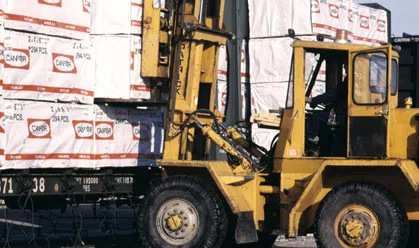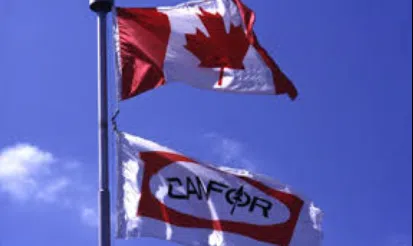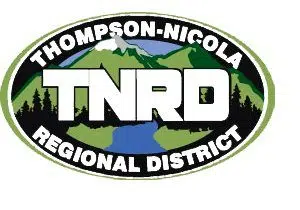
Loader lifting packed sheets of plywood at its operation in Fort St. John, which the company announced was saying goodbye to, along with a similar mill in Vanderhoof, last fall/via Canfor
The organization which speaks and bargains on behalf of the BC lumber industry has confirmed that a 34.45% hit to Canadian lumber products is most likely on the way this summer.
“The BC Lumber Trade Council (BCLTC) is deeply disappointed by the U.S. Department of Commerce’s preliminary decision to more than double countervailing duties on imports of Canadian softwood lumber from 6.74% to 14.38%,” stated the organization in a release on Sunday afternoon.
“Combined with Commerce’s preliminary decision earlier this year to increase anti-dumping duties to 20.07%, this could bring the total combined duty rate to 34.45% this fall if [the US Department of] Commerce maintains these rates in its final results.”

The Canfor and Canadian flags flying next to one another outside the company’s headquarters in downtown Vancouver/via Canfor
“British Columbia does not subsidize its lumber industry,” stated the BC Lumber Trade Council in its Sunday rebuke of the forthcoming countervailing penalties. “Timber in B.C. is sold through a transparent, market-based system. Claims that B.C.’s system provides an unfair advantage are simply not supported by the facts.”
“Commerce continues to employ flawed and misleading methodologies, resulting in the higher rates that were announced,” added the Lumber Trade Council.
“These duties are unjustified and harmful,” said Kurt Niquidet, President of the BC Lumber Trade Council. “Our stumpage system is grounded in market principles, with timber sold through open, competitive auctions.”

Train carrying West Fraser Timber wood products to market/via Woodworking Network
“The Council urges Commerce to reverse this preliminary decision in its final results,” continued the BC Lumber Trade Council. “If implemented, these rates will hurt workers and communities on both sides of the border and drive-up lumber prices for American consumers.”
Canfor currently has to leave 16.58% of the cost of any shipment at the Canada-US border in the form of a cash or bond payment. While Canfor may take some of the burden off its US customers, for the most part, company is just off-setting those costs by putting mostly on to their US brokers, who will in-turn, recoup their hit by charging more to the wholesaler, the wholesaler to the retailer, the retailer then over to the builder and the builder then on to the home buyer — where higher prices almost always end up.
It was that 16.58% that the company cited — in part — for its decision last fall to shutter a pair of its operations in Fort St. John and Vanderhoof, leaving over 500 people out of work and representing a difficult blow to the communities themselves.
If the 47% figure for Canfor is accurate, that would be more than triple its current export duties to the US, most likely prompting some difficult decisions ahead for the Vancouver-based firm, which employs close to 7,000 people in this province — many of them based in the Lower Mainland.
“BCLTC remains committed to fair, fact-based trade and will continue working with partners to defend Canada’s forestry sector,” the council added.












